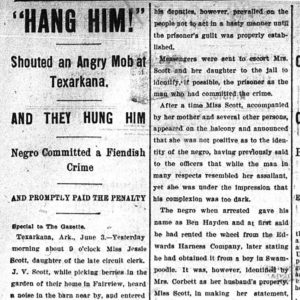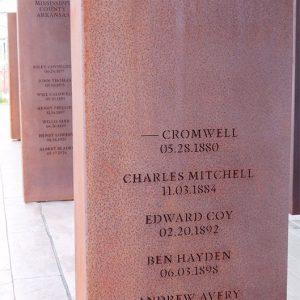calsfoundation@cals.org
Bud Hayden (Lynching of)
On June 3, 1898, Bud Hayden was lynched in Texarkana (Miller County) for allegedly assaulting twelve-year-old Jessie Scott, the daughter of the late James V. Scott, former circuit clerk. Although Hayden claimed to be twelve years old at the time, the authorities estimated his age to be at least eighteen. The Arkansas Gazette’s reports of the lynching were carried in newspapers across the country, including the Atlanta Constitution, the New York Times, and the Los Angeles Herald.
At the time of the 1880 census, J. V. Scott was living in Cut Off Township in Miller County. He was a twenty-four-year-old farmer living with his wife, Talitha, who was twenty. There was only one African-American family named Hayden in the county. Charley Haden (age twenty-nine) was living in Homan Township, a rural area northeast of Texarkana, with his wife Adline (age thirty) and four children. They were living in the household of William Daniels, and Charley was working as a farm laborer, while Adline was a servant. No one in the family was literate. They had only one male child, Charley, who was four years old at the time. If this is the correct Hayden family, and if Charley is the same as “Bud” Hayden, he would have been twenty-two at the time of the lynching.
According to the Arkansas Gazette, on the morning of June 2, 1898, Jessie Scott was picking berries at her home in Texarkana’s Fairview Addition. She heard a noise in the nearby barn, and when she went to investigate, she found a black man in the barn. When she asked him what he was doing there, he replied by asking her the same question. She then became frightened and said she was going to tell her mother. He allegedly grabbed her arm, “leaving the impression of his fingers.” The Scotts told Sheriff J. T. Dillon about the incident, but Dillon was unsuccessful in his search for the perpetrator. He returned to the Scott home later to obtain additional information. At this time, Talitha Scott told him that Jessie had been “criminally assaulted.” They had failed to report it earlier, she said, for fear of the publicity it would bring them. Dr. W. C. Spearman was brought in, and his examination reportedly confirmed the assault. Sheriff Dillon, Deputy Sheriff J. N. Crenshaw, and City Marshal W. E. Casey then scoured the nearby woods, to no effect.
As Casey was returning to town, he saw an African-American man on a bicycle. He arrested him and brought him back to town around 5:30 p.m. At the same time, authorities discovered that a bicycle had been stolen from the Corbett home, which was not far from the Scott home. They believed that the two crimes were connected, and Hayden was taken to the county jail.
The jail was soon surrounded “by hundreds of excited people, eager to wreak vengenace [sic] on the dastardly scoundrel.” Officers, having convinced them to hold off for the moment, brought Jessie Scott in to identify her attacker, but “she was not positive as to the identity of the negro, having previously said to the officers that while the man in many respects resembled her assailant, yet she was under the impression that his complexion was too dark.”
Nonetheless, Hayden was arrested. He allegedly told conflicting stories, saying at first that he had rented the bicycle, and then that he had gotten it from a boy in Swampoodle. Mrs. Corbett, however, identified the bicycle as one belonging to her husband. Jessie Scott then said that the man who assaulted her had an axe, which was found at the place where the bicycle had been stolen.
There was much excitement in town, and “hundreds of Texarkana’s leading citizens” stood guard outside the jail on the night of June 2. The crowd was estimated to be in the thousands by the following morning, and the Gazette declared that “a cooler headed mob never collected.” Although those involved were “determined to wreak vengeance on the guilty negro,” they decided that “seven of the best men in the city” would take Hayden to the Scott home so that Jessie could try to identify him once again. They put Hayden in the barn, and Jessie was brought in and positively identified him as her assailant.
They then brought Hayden back to the jail where, in front of the mob, “numerous speeches were made in which the case and as to what should be done was freely discussed.” One speaker, calling Hayden a brute who had “assaulted the twelve-year-old child of one of our departed citizens who was honored by everybody,” asked what, “in justice to his withered remains” they should do. Hundreds replied, “Hang him.”
Members of the mob put a rope around Hayden’s neck and dragged him through the crowd, “and everybody struck him as he passed.” They then adjusted the rope so it would not choke him and ran to a tree near the Iron Mountain Railroad crossing. Hayden refused to speak. He was hanged, and his body was riddled with bullets. The large crowd refused to leave the tracks, delaying a train for an hour. According to the Gazette, “His black body swung from the limb several hours and was viewed by thousands of people. There is no question but what the guilty one was punished.”
According to the census, Talitha Scott remained in Miller County. In 1900, she was living in Texarkana, and Jessie Scott, whose birthdate was given as 1882, was living with her. Jessie’s age might be a mistake on the part of the census worker, but if it is accurate, it would indicate that Jessie was older than twelve when she was assaulted. By 1910, Talitha Scott was living in Garland Township, but Jessie was no longer living with her. There is no sign of any member of the Hayden family in the 1900 Miller County census.
For additional information:
“Arkansas Mob Hangs a Negro.” Atlanta Constitution, June 4, 1898, p. 3.
“‘Hang Him!’ Shouted an Angry Mob at Texarkana.” Arkansas Gazette, June 4, 1898, p. 3.
“Lynching at Texarkana.” Forrest City Times, June 10, 1898, p. 1.
“Negro Lynched in Arkansas.” New York Times, June 5, 1898, p. 11.
“Two Negroes Lynched.” Los Angeles Herald, June 4, 1898, p. 3.
Nancy Snell Griffith
Clinton, South Carolina
 Civil Rights and Social Change
Civil Rights and Social Change Post-Reconstruction through the Gilded Age, 1875 through 1900
Post-Reconstruction through the Gilded Age, 1875 through 1900 Haden Lynching Article
Haden Lynching Article  Miller County Lynching
Miller County Lynching 




Comments
No comments on this entry yet.